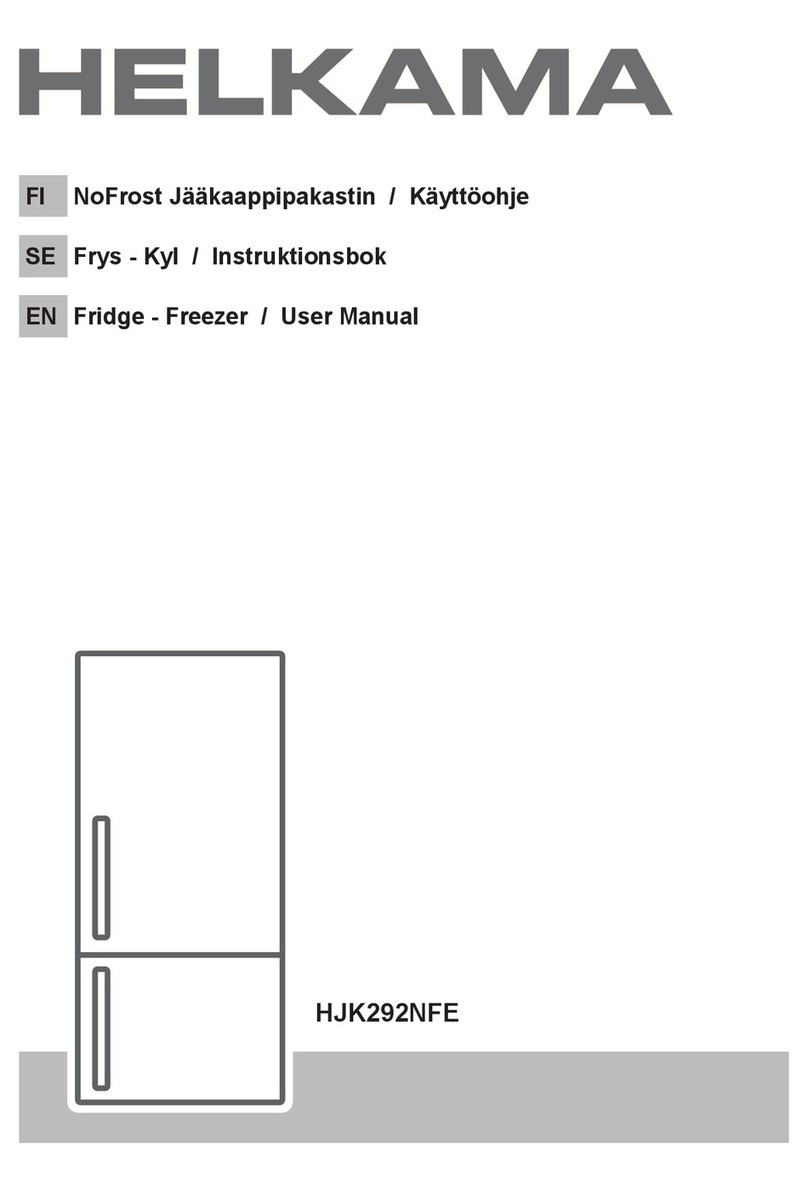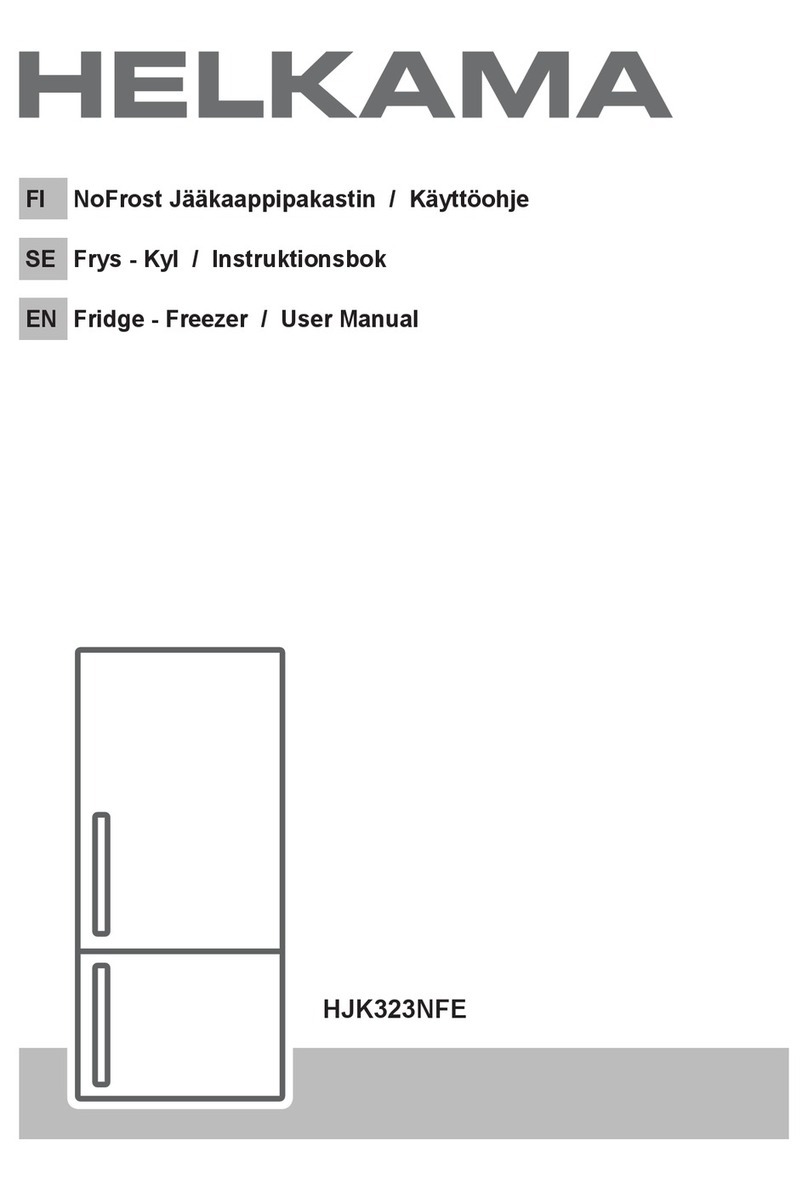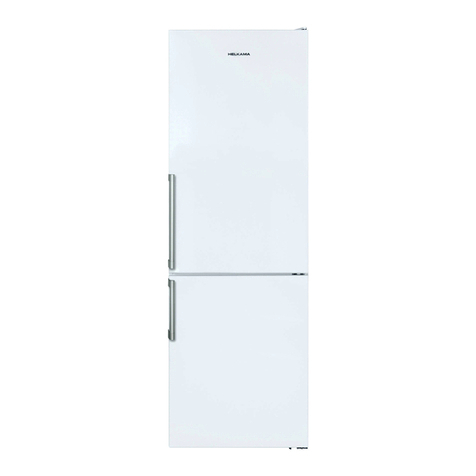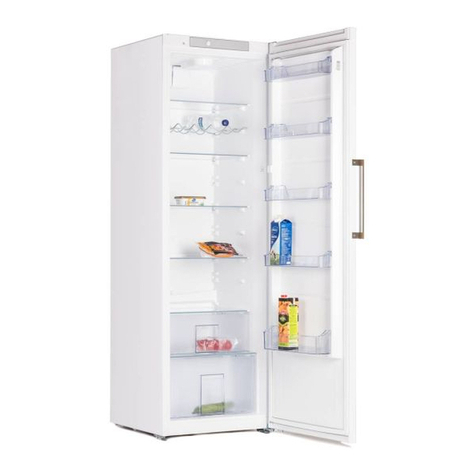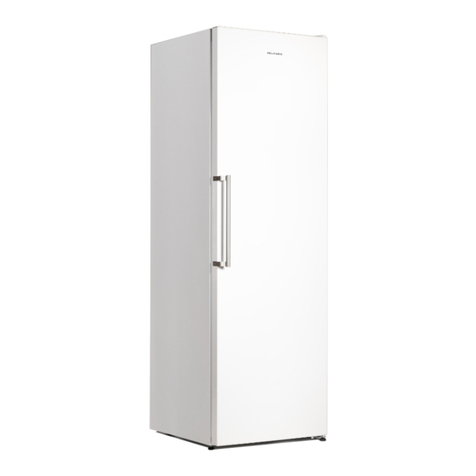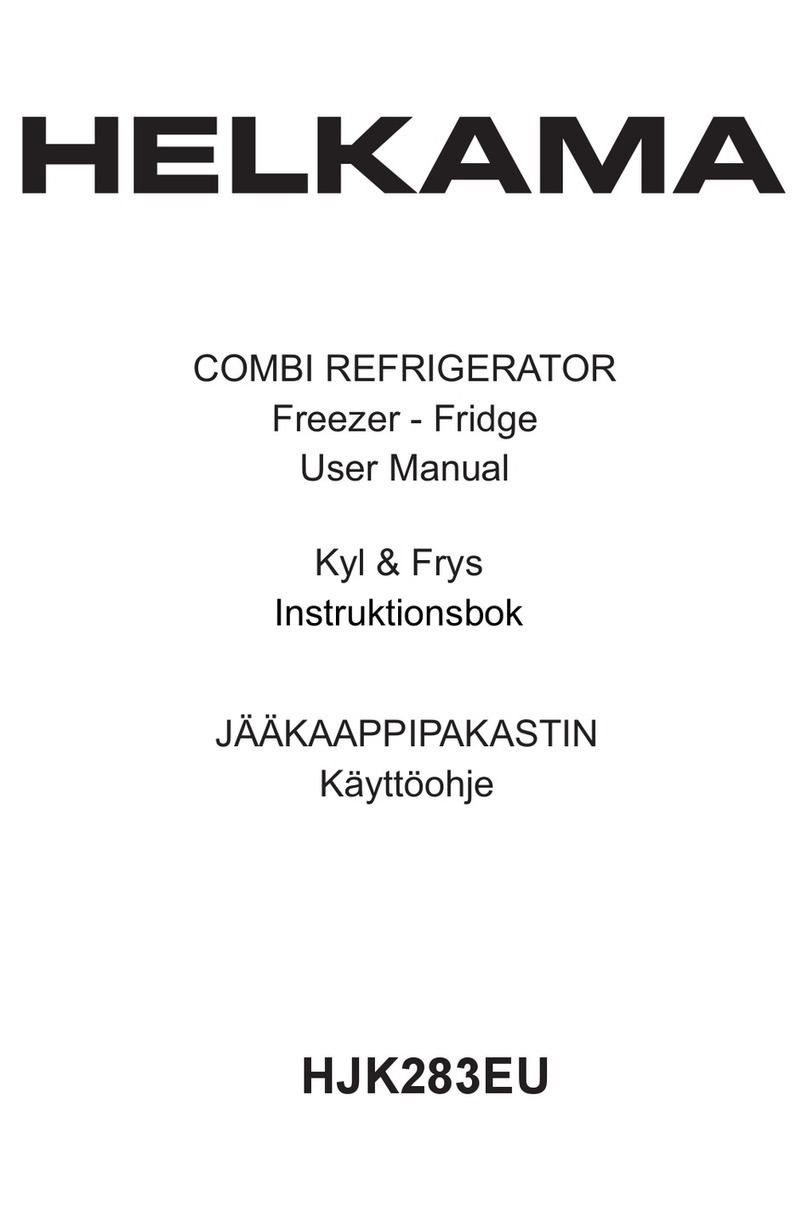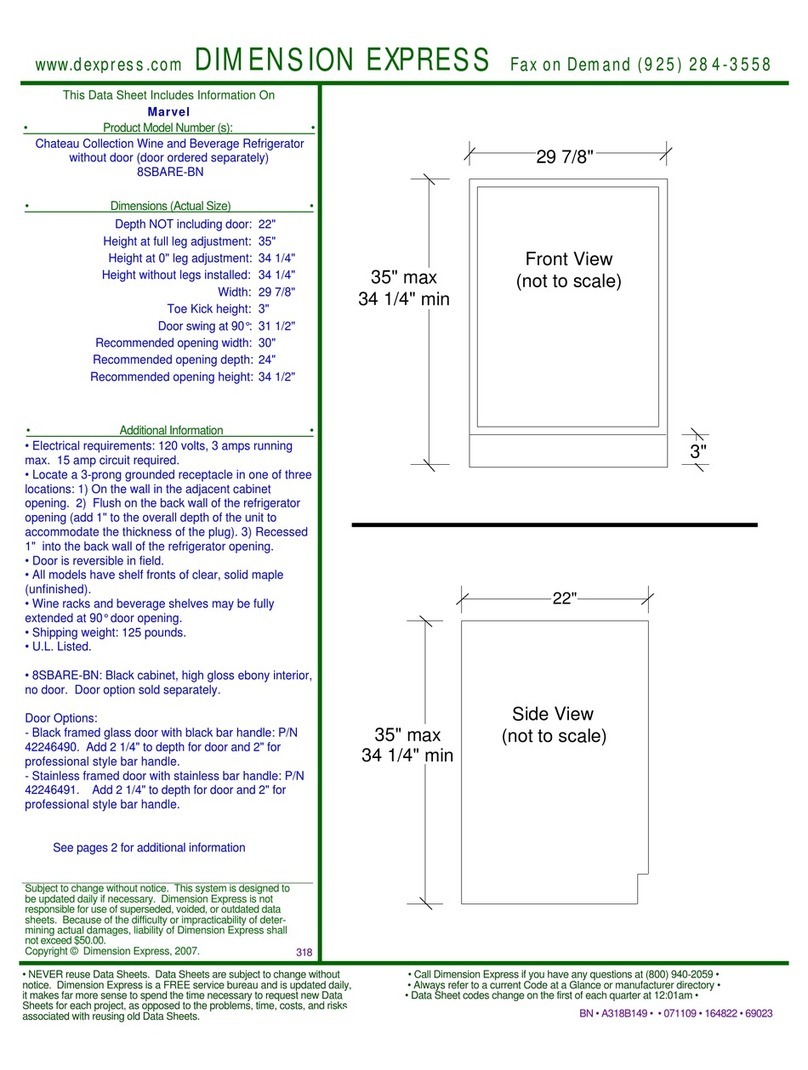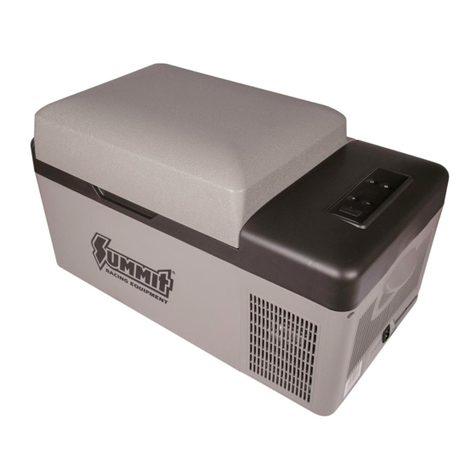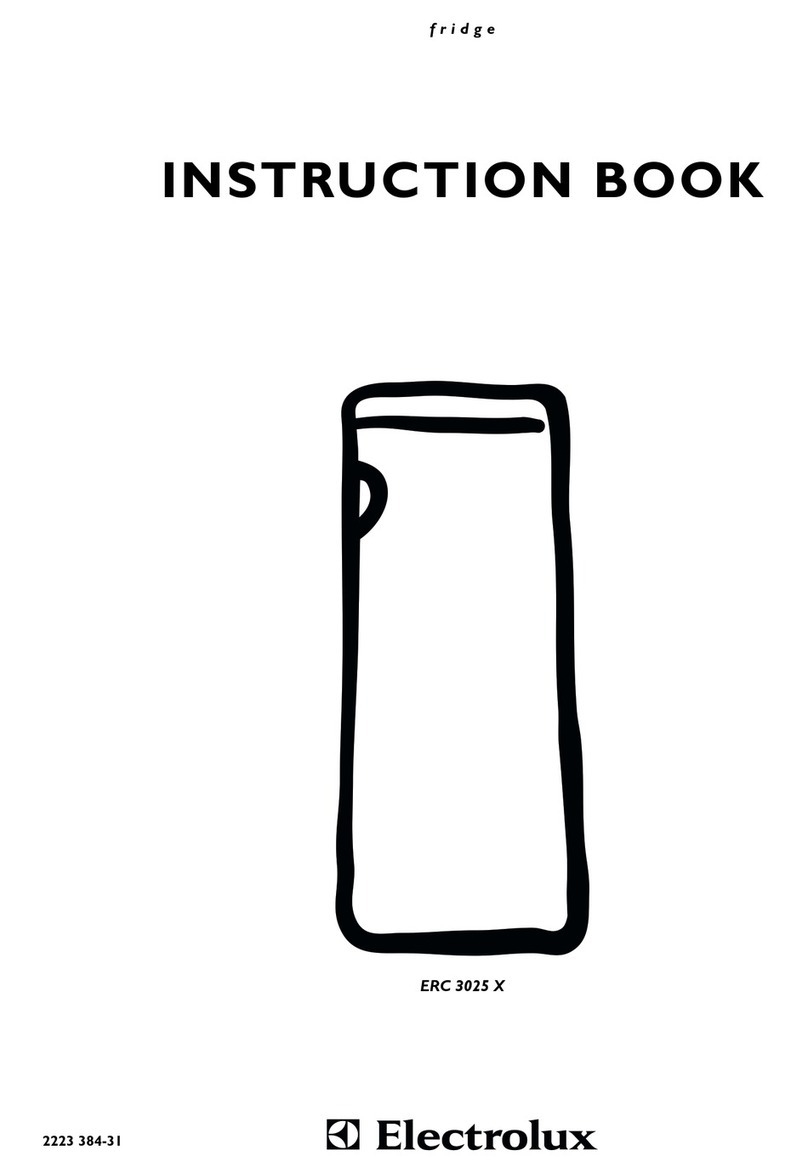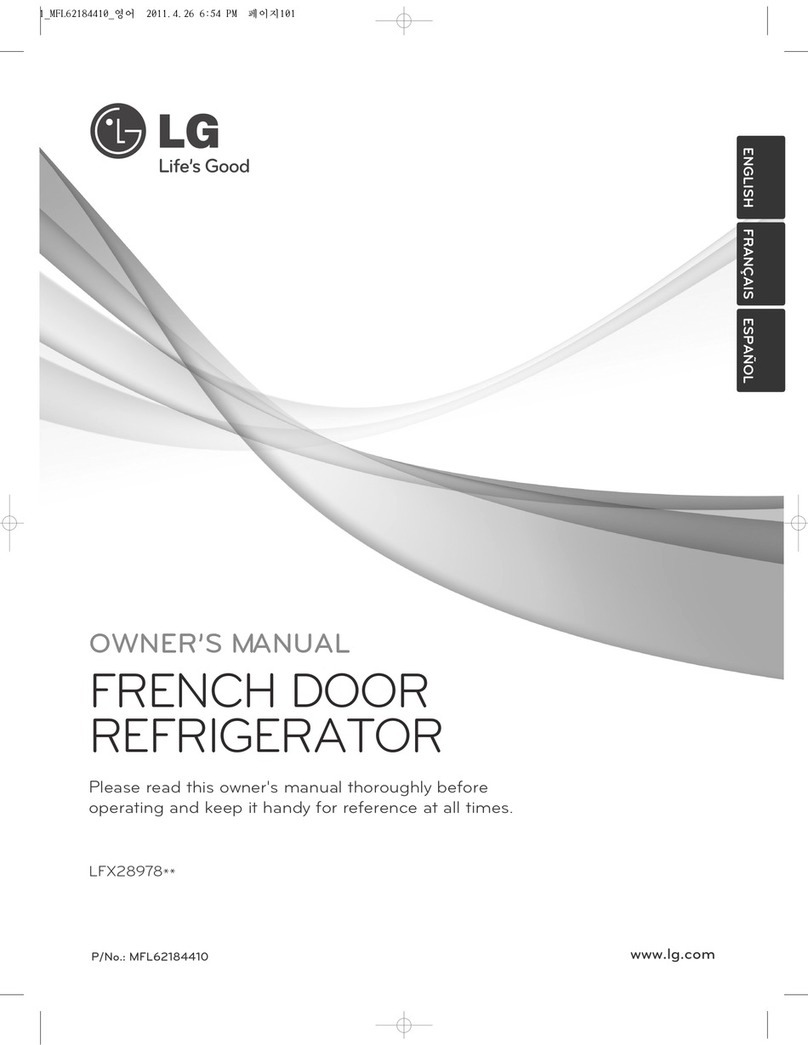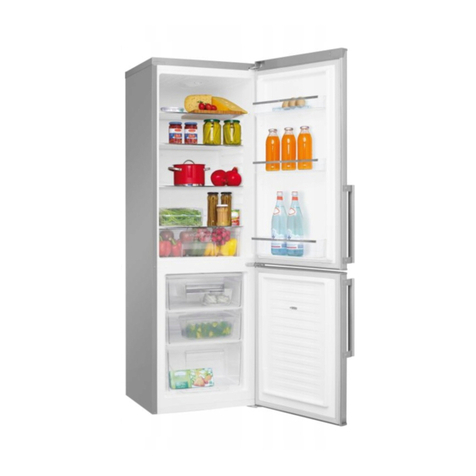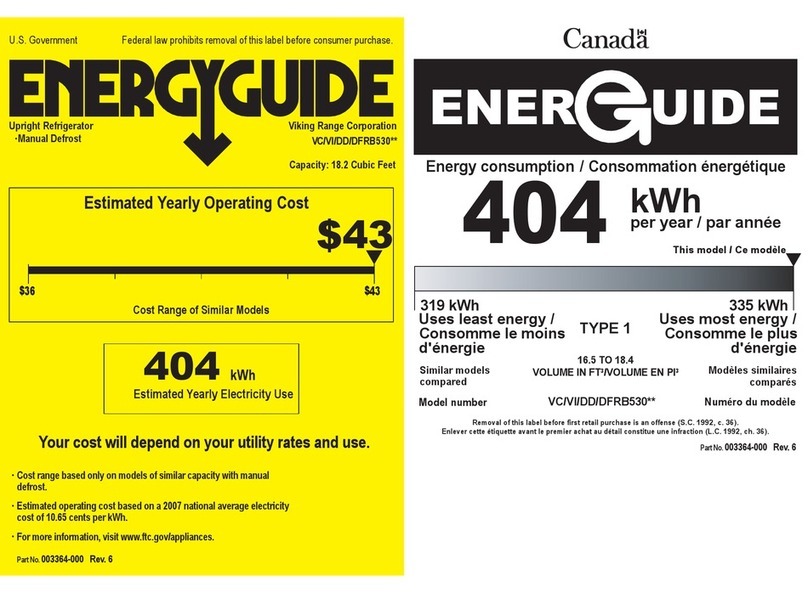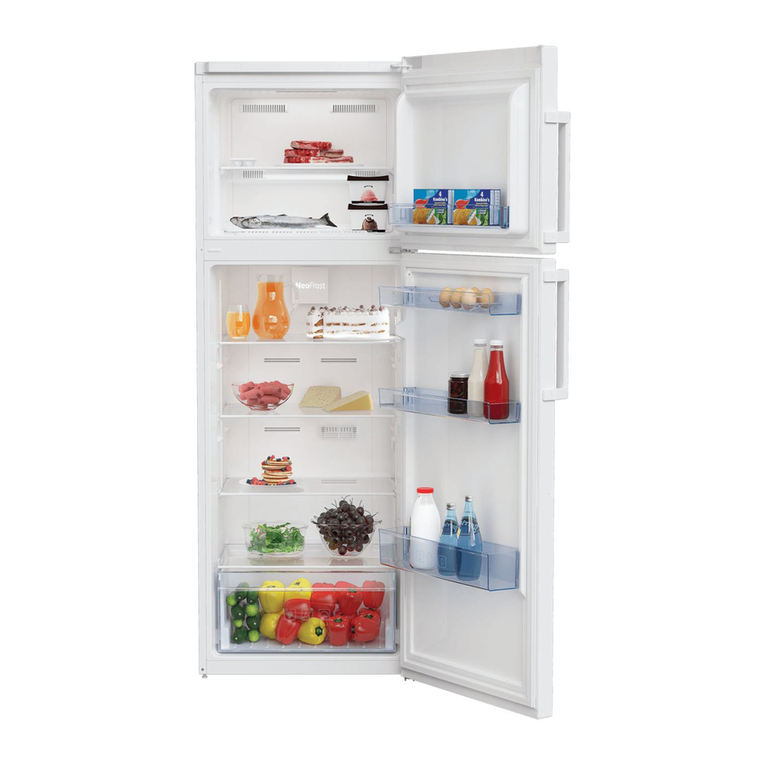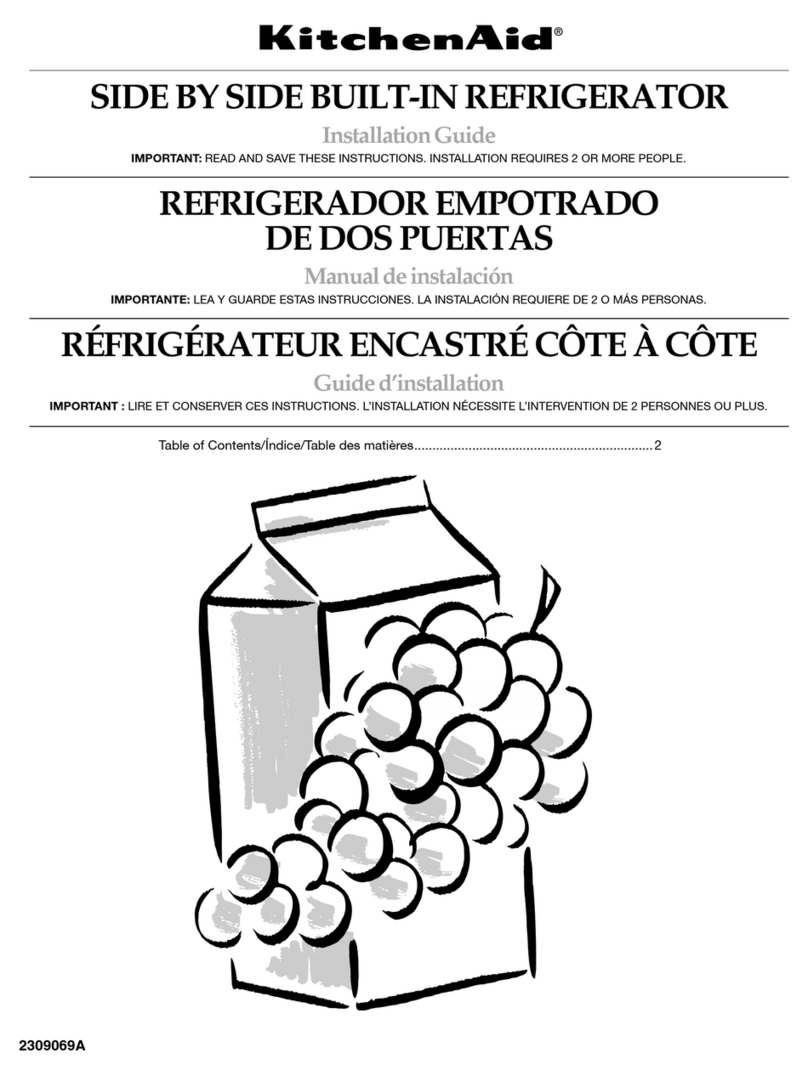HELKAMA HJK289 User manual

HJK289
Combı Refrıgerator
Fridge-freezer
Instruction booklet
Kyl & Frys
instruktionsbok
Jääkaappipakastin
äK yttöohje


EN - 1 -
Index
BEFORE USING THE APPLIANCE .......................................................... 2
General warnings ........................................................................................2
Old and out-of-order fridges ........................................................................4
Safety warnings ...........................................................................................4
Installing and operating your fridge .............................................................5
Before using your fridge freezer ..................................................................6
Information about New Generation Cooling Technology .............................6
HOW TO OPERATE THE APPLIANCE..................................................... 7
Display and control panel ............................................................................7
Operating your fridge...................................................................................7
Cooler temperature settings ......................................................................................7
Super cool mode .......................................................................................................7
Economy mode .........................................................................................................8
Warnings about Temperature Adjustments..................................................8
Accessories .................................................................................................8
Ice tray .......................................................................................................................8
Bottle holder...............................................................................................................9
Adjustable Door Shelf ...............................................................................................9
FOOD STORAGE IN THE APPLIANCE.................................................. 10
Refrigerator compartment..........................................................................10
Freezer compartment ................................................................................10
CLEANING AND MAINTENANCE .......................................................... 14
Defrosting ..................................................................................................15
TRANSPORTATION AND CHANGING OF INSTALLATION POSITION 15
Repositioning the door...............................................................................15
BEFORE CALLING FOR AFTER SALES SERVICE .............................. 16
Tips for saving energy ...............................................................................18
PARTS OF THE APPLIANCE AND THE COMPARTMENTS ................. 19
The operating instructions apply to several models. Differences may therefore occur.

EN - 2 -
BEFORE USING THE APPLIANCE
General warnings
WARNING: Keep ventilation openings, in the appliance
enclosure or in the built-in structure, clear of obstruction.
WARNING: Do not use mechanical devices or other means
to accelerate the defrosting process, other than those recom-
mended by the manufacturer.
WARNING: Do not use electrical appliances inside the food
storage compartments of the appliance, unless they are of the
type recommended by the manufacturer.
WARNING: Do not damage the refrigerant circuit.
WARNING: In order to avoid any hazards resulting from the in-
stability of the appliance, it must be xed in accordance with the
following instructions:
• If your appliance uses R600a as a refrigerant (this information
will be provided on the label of the cooler) you should
take care during transportation and installation to prevent
the cooler elements from being damaged. R600a is an
environmentally friendly and natural gas, but it is explosive.
In the event of a leak due to damage of the cooler elements,
move your fridge away from open ames or heat sources
and ventilate the room where the appliance is located for a
few minutes.
• While carrying and positioning the fridge, do not damage the
cooler gas circuit.
• Do not store explosive substances such as aerosol cans
with a ammable propellant in this appliance.
• This appliance is intended to be used in household and
domestic applications such as:
- staff kitchen areas in shops, ofces and other working en-
vironments.
PART - 1.

EN - 3 -
- farm houses and by clients in hotels, motels and other resi-
dential type environments.
- bed and breakfast type environments;
- catering and similar non-retail applications.
• If the socket does not match the refrigerator plug, it must be
replaced by the manufacturer, a service agent or similarly
qualied persons in order to avoid a hazard.
• A specially grounded plug has been connected to the power
cable of your refrigerator. This plug should be used with a
specially grounded socket of 10 or 16 amperes depending
on socket loading. If there is no such socket in your house,
please have one installed by an authorised electrician..
• This appliance can be used by children aged from 8 years
and above and persons with reduced physical, sensory or
mental capabilities or lack of experience and knowledge if
they have been given supervision or instruction concerning
use of the appliance in a safe way and understand the
hazards involved. Children shall not play with the appliance.
Cleaning and user maintenance shall not be made by
children without supervision.
• If the supply cord is damaged, it must be replaced by
the manufacturer, an authorised service agent or similar
qualied persons, in order to avoid a hazard.
• This appliance is not intended for use at altitudes exceeding
2000 m.

EN - 4 -
Old and out-of-order fridges
• If your old fridge has a lock, break or remove the lock before discarding it, because
children may get trapped inside it and may cause an accident.
• Old fridges and freezers may contain isolation material and refrigerant with CFC or HFC.
Therefore, take care not to harm environment when you are discarding your old
fridges.
Please ask your municipal authority about the disposal of the WEEE reuse, recycle
and recovery purposes.
Notes:
• Please read the instruction manual carefully before installing and using your appliance.
We are not responsible for the damage occurred due to misuse.
• Follow all instructions on your appliance and instruction manual, and keep this manual in
a safe place to resolve the problems that may occur in the future.
• This appliance is produced to be used in homes and it can only be used in domestic
environments and for the specied purposes. It is not suitable for commercial or
common use. Such use will cause the guarantee of the appliance to be cancelled and
our company will not be responsible for losses incurred.
• This appliance is produced to be used in houses and it is only suitable for cooling / storing
food. It is not suitable for commercial or common use and/or for storing substances
except for food. Our company is not responsible for losses to be incurred in the contrary
case.
Safety warnings
• Do not connect your fridge freezer to the mains electricity supply using an extension
lead.
• Do not plug in damaged, torn or old plugs.
• Do not pull, bend or damage the cord.
• This appliance is designed for use by adults, do not allow children to play
with the appliance or let them hang off the door.
• Never touch the power cord/plug with wet hands as this could cause a short
circuit or electric shock.
• Do not place glass bottles or beverage cans in the ice-making compartment
as they can burst as the contents freeze.
• Do not place explosive or ammable material in your fridge. Place drinks
with high alcohol content vertically in the fridge compartment and make
sure that their tops are tightly closed.
• When removing ice from the ice-making compartment, do not touch it. Ice may
cause frost burns and/or cuts.
• Do not touch frozen goods with wet hands! Do not eat ice-cream and ice cubes
immediately after you have taken them out of the freezer department!

EN - 5 -
• Do not touch frozen goods with wet hands. Do not eat ice-cream or ice cubes immediately
after you have taken them out of the ice-making compartment.
• Do not cover the body or top of fridge with lace. This affects the performance of your
fridge.
• Secure any accessories in the fridge during transportation to prevent damage to the
accessories.
Installing and operating your fridge
Before starting to use your fridge freezer, you should pay attention to the following points:
• The operating voltage for your fridge is 220-240 V at 50Hz.
• The plug must be accessible after installation.
• Your fridge freezer may have a smell when it is operated for the rst time. This is normal
and the smell will fade away when your fridge freezer starts to cool.
• Before connecting your fridge freezer, ensure that the information on the data plate
(voltage and connected load) matches that of the mains electricity supply. If in doubt,
consult a qualied electrician.
• Insert the plug into a socket with an efcient ground connection. If the socket has no
ground contact or the plug does not match, we recommend that you consult a qualied
electrician for assistance.
• The appliance must be connected with a properly installed fused socket. Power supply
(AC) and voltage at the operating point must match with the details on the name plate of
the appliance (name plate is located on the inside left of the appliance).
• We do not accept responsibility for any damages that occur due to ungrounded usage.
• Place your fridge where it will not be exposed to direct sunlight.
• Your fridge should never be used outdoors or exposed to rain.
• Your appliance should be at least 50 cm away from stoves, gas ovens and heater cores,
and at least 5 cm away from electrical ovens.
• When your fridge is placed next to a deep freezer, there should be at least 2 cm between
them to prevent humidity forming on the outer surface.
• Do not place heavy items on the appliance.
• Clean the appliance thoroughly, especially the interior, before use (see
Cleaning and Maintenance).
• The installation procedure into the kitchen unit is given in the installation
manual. This product is intended to be used in proper kitchen units only.
• Before using your fridge freezer, wipe all parts with a solution of warm water
and a teaspoon of sodium bicarbonate, then rinse with clean water and dry. Place all
parts in the fridge after cleaning.
• Install the plastic distance guide (the part with black vanes at the rear)
by turning it 90° (as shown in the gure) to prevent the condenser from
touching the wall.
• The refrigerator should be placed against a wall with a free space not
exceeding 75 mm.

EN - 6 -
Before using your fridge freezer
• When using your fridge freezer for the rst time, or after transportation, keep
it in an upright position for at least 3 hours before plugging into the mains.
This allows efcient operation and prevents damage to the compressor.
• Your fridge freezer may have a smell when it is operated for the rst time. This is normal
and the smell will fade away when your fridge starts to cool.
Information about New Generation Cooling Technology
Fridges with new generation cooling technology have a different working
system than static fridges. In normal fridges, humid air that enters into
fridge and the water vapor that comes out from the foods, accumulates
frost formation in freezer compartment. In order to melt this frost, in other
words defrost, the fridge has to be stopped. During the stopping period,
to keep the foods cold, user has to extract the food to outside of fridge
and user has to clear the ice during this period.
In the fridges with new generation cooling technology, situation in the
freezer compartment is completely different. With the aid of fan, cold and
dry air is blown out through many points into the freezer compartment.
As a result of the homogenously blown cold air, even in the spaces
between shelves, foods are frozen equally and correctly. On the other
hand there will be no frost formation.
In the refrigerator compartment, there will be nearly same conguration
with freezer compartment. Air, that is emitted with the fan, located at the
top of refrigerator compartment, is cooled while passing through the gap
behind the air duct. At the same time, air is blown out through the holes
on the air duct so that cooling process is successfully completed in the
refrigerator compartment. Holes on the air duct are designed such that
the air distribution becomes homogenous in this compartment.
As there is no air passage between freezer and refrigerator compartment, there will be no
odor mixing.
As a result of these, your fridge with new generation cooling technology, gives you, ease of
use beside the huge volume and esthetic appearance.

EN - 7 -
HOW TO OPERATE THE APPLIANCEPART - 2.
Display and control panel
C
o
8 6 5 4 2
It is Economy mode
indicator.
It is Super cool mode
indicator.
Set button
Thermostat set level
indicator
Button LED
Operating your fridge
Cooler temperature settings
• Initial temperature value for Cooler Setting Indicator is 6 oC.
• Press set button once, the set value will start to blink.
• If you keep pressing set button, lower temperatures will be selected. (8, 6, 5, 4, 2, super
and eco)
• If no button is pressed for 1 second, your choice will be set, it will blink 3 times. Buzzer
will sound beep beep.
• The temperature value selected before Super Cool Mode or Economy Mode is activated
will remain the same when the mode is over or cancelled. The appliance continues to
operate with this temperature value.
Super cool mode
How would it be used?
Press set button until super cool symbol will be seen on the screen. Buzzer will sound
beep beep. Mode will be set.
During this mode:
• Economy mode can not be selected.
• Super cool mode can be cancelled by the same operation of selecting.

EN - 8 -
Economy mode
How would it be used?
Press set button until eco symbol will be seen on the screen. Buzzer will sound beep
beep. Mode will be set.
During this mode:
• Super cool can be selected. Economy mode is automatically cancelled and the
selected mode is activated.
• Eco mode can be cancelled by the same operation of selecting.
Warnings about Temperature Adjustments
• Temperature adjustments should be made according to the frequency of door openings
and the quantity of food kept inside the fridge.
• Do not pass to another adjustment before completing an adjustment.
• Your fridge should be operated up to 24 hours according to the ambient temperature
without interruption after being plugged in to be completely cooled. Do not open doors
of your fridge frequently and do not place much food inside it in this period.
• A 5 minute delaying function is applied to prevent damage to the compressor of your
fridge, when you take the plug out and then plug it in again to operate it or when an
energy breakdown occurs. Your fridge will start to operate normally after 5 minutes.
• Your fridge is designed to operate in the ambient temperature intervals stated in the
standards, according to the climate class stated in the information label. We do not
recommend operating your fridge out
of stated temperatures value limits in
terms of cooling effectiveness.
• This appliance is designed for use at an
ambient temperature within the 16°C -
38°C range.
Climate class Ambient temperature (oC)
TBetween 16 and 43 oC
ST Between 16 and 38 oC
NBetween 16 and 32 oC
SN Between 10 and 32 oC
Accessories
Ice tray
• Fill the ice tray with water and place in freezer compartment.
• After the water completely turned into ice, you can twist the tray as shown below to get
the ice cube.

EN - 9 -
Bottle holder
In order to prevent bottles from slipping or falling over, you can use the bottle
holder. This will also help to prevent the noise made by bottles when opening
or closing the door.
(Only some models)
Adjustable Door Shelf
Six different height adjustments can be made to provide storage areas that you need by
adjustable door shelf .
To change the position of adjustable door shelf;
• Hold the bottom of the shelf and pull the buttons
on the side of the door shelf direction of arrow.
(Fig.1)
• Position door shelf the height you need by moving
up and down. After you get the position that you
want the door shelf, release the buttons on the
side of the door shelf (Fig.2) Before releasing the
door shelf, move up down and make sure the door shelf is xed.
Note: Before moving door shelf is loaded, you must hold the shelf by supporting the bottom.
Otherwise, door shelf could fall off the rails due to the weight. So damage may occur on the
door shelf or rails.
Figure -1 Figure -2
All written and visual descriptions in the accessories may vary according to
the appliance model.

EN - 10 -
Refrigerator compartment
The refrigerator compartment is used for storing fresh food for a few days.
• Do not place food in direct contact with the rear wall of the refrigerator compartment.
Leave some space around food to allow circulation of air.
• Do not place hot food or evaporating liquid in the refrigerator.
• Always store food in closed containers or wrapped.
• To reduce humidity and avoid formation of frost, never place liquids in unsealed containers
in the refrigerator.
• Meat of all types, wrapped in packages, is recommended to be placed on the glass shelf
just above the vegetable bin, where the air is colder.
• You can put fruit and vegetables into the crisper without packaging.
• To avoid cold air escaping, try not to open the door too often, and not leave the door open
for a long time.
Some recommendations have been specied below for the placement and storage of your
food in the cooling compartment.
FOOD STORAGE IN THE APPLIANCEPART - 3.
Food Maximum Storing time Where to place in the
fridge department
Vegetables and fruits 1 week Vegetable bin
Meat and sh 2 - 3 Days
Wrapped in plastic foil or bags or in
a meat container
(on the glass shelf)
Fresh cheese 3 - 4 Days In special door shelf
Butter and margarine 1 week In special door shelf
Bottled products
milk and yoghurt
Until the expiry date
recommended by the
producer
In special door shelf
Eggs 1 month In the egg shelf
Cooked food All shelves
NOTE: Potatoes, onions and garlic should not be stored in the refrigerator.
Freezer compartment
The freezer compartment is used for freezing fresh food and for storing frozen food for the
period of time indicated on packaging, and for making ice cubes.
• When freezing fresh food, wrap and seal the food properly; the packaging should be air
tight and shouldn’t leak. Special freezer bags, aluminum foil (heavy grade, if in doubt
double wrap), polythene bags and plastic containers are ideal.
• To get maximum capacity for freezer compartment, please just use glass shelves for
upper and middle section. For bottom section, please use lower basket.
• The maximum amount of fresh foods that can be loaded in the freezer within 24 hours is
indicated on the name plate (see Freezing Capacity).

EN - 11 -
• For optimum appliance performance to reach maximum freezing capacity, Set the
refrigerator at 2 oC for 24 hours before placing fresh food into the freezer.
• After placing fresh food into the freezer, change the setting to 2 oC for 24 hours is
generally sufcient. After 24 hours, you can reduce the setting if required.
• Do not allow the fresh food to be frozen to come into contact with the already frozen food.
• Always mark the date and the content on the pack and do not exceed the stated storage
time.
• In case of a power failure or malfunction, the freezer compartment will maintain a
sufciently low temperature for food storage. However, avoid opening the freezer door
to slow down the temperature rise within the freezer compartment.
• Never place warm food in the freezer compartment.
• When purchasing and storing frozen food products, ensure that the packaging is not
damaged.
• The storage time and the recommended temperature for storing frozen food is indicated
on the packaging. For storing and using, follow the manufacturer’s instructions. If no
information is provided, food should not be stored for more than 3 months.
• Place frozen food in the freezer compartment as soon as possible after buying it.
• Once the food has thawed, it must not be refrozen; you must cook it as quickly as possible
in order to consume or to freeze once again.
• Not that; if you want to open again immediately after closing the freezer door, it will not
be opened easily. It’s quite normal! After reaching equilibrium condition, the door will be
opened easily.
Important note:
• Frozen foods, when thawed, should be cooked just like fresh foods. If they are not cooked
after being thawed they must NEVER be re-frozen.
• The taste of some spices found in cooked dishes (anise, basilica, watercress, vinegar,
assorted spices, ginger, garlic, onion, mustard, thyme, marjoram, black pepper, etc.)
changes and they assume a strong taste when they are stored for a long period.
Therefore, the frozen food should be added little amount of spices or the desired spice
should be added after the food has been thawed.
• The storage period of food is dependent on the oil used. The suitable oils are margarine,
calf fat, olive oil and butter and the unsuitable oils are peanut oil and pig fat.
• The food in liquid form should be frozen in plastic cups and the other food should be
frozen in plastic folios or bags.

EN - 12 -
Meat and sh Preparation
Maximum
Storing time
(month)
Steak Wrapping in a foil 6 - 8
Lamb meat Wrapping in a foil 6 - 8
Veal roast Wrapping in a foil 6 - 8
Veal cubes In small pieces 6 - 8
Lamb cubes In pieces 4 - 8
Minced meat In packages without using spices 1 - 3
Giblets (pieces) In pieces 1 - 3
Bologna sausage/salami Should be packaged even if it has
membrane
Chicken and turkey Wrapping in a foil 4 - 6
Goose and Duck Wrapping in a foil 4 - 6
Deer, Rabbit, Wild Boar In 2.5 kg portions and as llets 6 - 8
Fresshwater shes (Salmon,
Carp, Crane, Siluroidea) After cleaning the bowels and
scales of the sh, wash and dry it;
and if necessary, cut the tail and
head.
2
Lean sh; bass, turbot,
ounder 4
Fatty shes (Tunny, Mackarel,
bluesh, anchovy) 2 - 4
Shellsh Cleaned and in bags 4 - 6
Caviar In its package, aluminium or
plastic container 2 - 3
Snail In salty water, aluminum or plastic
container 3
Note: Frozen meat should be cooked as fresh meat after being thawed. If the meat is not
cooked after being thawed, it should never be frozen again.

EN - 13 -
Vegetables and Fruits Preparation
Maximum
Storing time
(months)
String beans and beans Wash and cut to small pieces and boil in
water 10 - 13
Beans Hull and wash and boil in water 12
Cabbage Cleaned and boil in water 6 - 8
Carrot Clean and cut to slices and boil in water 12
Pepper Cut the stem, cut into two pieces and
remove the core and boil in water 8 - 10
Spinach Washed and boil in water 6 - 9
Cauliower
Take the leaves apart, cut the heart into
pieces, and leave it in water with a little
lemon juice for a while
10 - 12
Eggplant Cut to pieces of 2cm after washing 10 - 12
Corn Clean and pack with its stem or as sweet
corn 12
Apple and pear Peel and slice 8 - 10
Apricot and Peach Cut into two pieces and remove the stone 4 - 6
Strawberry and
Blackberry Wash and hull 8 - 12
Cooked fruits Adding 10 % of sugar in the container 12
Plum, cherry, sourberry Wash and hull the stems 8 - 12

EN - 14 -
Dairy Products Preparation Maximum Storing
time (months) Storing Conditions
Packet
(Homogenize) Milk In its own packet 2 - 3 Pure Milk – In its own
packet
Cheese-excluding
white cheese In slices 6 - 8
Original package may
be used for short storing
period. It should be
wrapped in foil for longer
periods.
Butter, margarine In its package 6
Maximum Storing
time (months)
Thawing time in
room temperature
(hours)
Thawing time in oven
(minutes)
Bread 4 - 6 2 - 3 4-5 (220-225 °C)
Biscuits 3 - 6 1 - 1,5 5-8 (190-200 °C)
Pastry 1 - 3 2 - 3 5-10 (200-225 °C)
Pie 1 - 1,5 3 - 4 5-8 (190-200 °C)
Phyllo dough 2 - 3 1 - 1,5 5-8 (190-200 °C)
Pizza 2 - 3 2 - 4 15-20 (200 °C)
CLEANING AND MAINTENANCEPART - 4.
• Disconnect the unit from the power supply before cleaning.
• Do not clean the appliance by pouring water.
• Make sure that no water enters the lamp housing and other electrical
components.
• The refrigerator should be cleaned periodically using a solution of
bicarbonate of soda and lukewarm water.
• Clean the accessories separately with soap and water Do
not clean them in the dishwasher.
• Do not use abrasive products, detergents or soaps. After washing, rinse
with clean water and dry carefully. When you have nished cleaning,
reconnect the plugto the mains supply with dry hands.

EN - 15 -
• Clean the condenser with a broom at least twice a year. This
will help you to save on energy costs and increase productivity.
THE POWER SUPPLY MUST BE DISCONNECTED.
Defrosting
Your refrigerator has fully automatic defrosting. The water
formed as a result of defrosting passes through the water
collection spout, ows into the vaporisation container below
the condenser and evaporates there.
Evaporating
tray
TRANSPORTATION AND CHANGING OF
INSTALLATION POSITION
Transportation and Changing of Installation Position
• The original packages and foamed polystyrene (PS) can be retained if required.
• During transportation, the appliance should be secured with a wide string or a strong
rope. The instructions written on the corrugated box must be followed while transporting.
• Before transporting or changing the installation position, all
the moving objects (ie,shelves,crisper…) should be taken
out or xed with bands in order to prevent them from getting
damaged.
!Carry your fridge in the upright position.
PART - 5.
Repositioning the door
• It is not possible to change the opening direction of your refrigerator door, if the door
handles on your refrigerator are installed from the front surface of the door.
• It is possible to change the opening direction of the door on models without any handles.
• If the door opening direction of your refrigerator may be changed, you should contact the
nearest authorised service agent to have the opening direction changed.
Replacing LED lighting
If your refrigerator has LED lighting contact the help desk as this should be changed by
authorized personnel only.

EN - 16 -
BEFORE CALLING FOR AFTER SALES SERVICEPART - 6.
Check Warnings;
Your fridge warns you if there is/are some part(s) out of order. In this case, LED around the
button will blink and buzzer will sound beep.
MEANING WHY WHAT TO DO
"Failure
Warning"
There is/are some
part(s) Out of order
Call Service for
assistance as soon as
possible.
If your fridge-freezer is not operating;
• Is there a power failure?
• Is the plug connected to the socket correctly?
• Is the fuse of the socket to which the plug is connected or the main fuse blown?
• Is there any failure at the socket? To check this, plug your refrigerator to a socket this is
surely operating.
If your fridge-freezer is not cooling enough;
• Is the temperature adjustment right?
• Are the doors of your fridge-freezer opened frequently and left open for a long while?
• Are the doors of fridge-freezer closed properly?
• Did you put a dish or food on your fridge-freezer so that it contacts the rear wall of your
fridge-freezer so as to prevent the air circulation?
• Is your fridge-freezer lled excessively?
• Is there adequate distance between your fridge-freezer and the rear and side walls?
• Is the ambient temperature within the range of values specied in the operating manual?
If the food in your refrigerator compartment is over cooled
• Is the temperature adjustment right?
• Are there many food recently put inside the freezer compartment? If so, your fridge-
freezer may over cool the food inside the fridge compartment as it will operate longer to
cool these food.
If your fridge-freezer is operating too loudly;
To maintain the set cooling level, compressor may be activated from time to time. Noises
from your fridge-freezer at this time are normal and due to its function. When the required
cooling level is reached, noises will be decreased automatically. If the noises persist;
• Is your appliance stable? Are the legs adjusted?
• Is there anything behind your fridge-freezer?
• Are the shelves or dishes on the shelves vibrating? Re-place the shelves and/or dishes
if this is the case.
• Are the items placed on your fridge-freezer vibrating?
Normal Noises;
Cracking (Ice cracking) Noise:
• During automatic defrosting.

EN - 17 -
• When the appliance is cooled or warmed (due to expansion of appliance material).
Short cracking: Heard when the thermostat switches the compressor on/off.
Compressor noise (Normal motor noise): This noise means that the compressor
operates normally Compressor may cause more noise for a short time when it is activated.
Bubbling noise and splash: This noise is caused by the ow of the refrigerant in the
tubes of the system.
Water ow noise: Normal ow noise of water owing to the evaporation container during
defrosting. This noise can be heard during defrosting.
Air Blowing Noise (Normal fan noise): This noise can be heard in No-Frost refrigerator
during normal operation of the system due to the circulation of air.
If humidity builds up inside the fridge-freezer;
• Are all food packed properly? Are the containers dried before placing them in the fridge-
freezer?
• Are the fridge-freezer doors opened frequently? Humidity of the room gets in the fridge-
freezer when the doors are opened. Humidity build up will be faster when you open the
doors more frequently, especially if the humidity of the room is high.
If the doors are not opened and closed properly;
• Do the food packages prevent closing of the door?
• Are the door compartments, shelves and drawers placed properly?
• Are door gaskets broken or torn?
• Is your fridge-freezer on a level surface?
If the edges of fridge cabinet that the door joint contact are warm;
Especially in summer (hot weather), the surfaces that the joint contact may get warmer
during the operation of the compressor, this is normal.
IMPORTANT NOTES:
• Compressor protection function will be activated after sudden power breakdowns or after
unplugging the appliance, because the gas in the cooling system is not stabilized yet.
Your fridge-freezer will start after 5 minutes, there is nothing to worry about.
• If you will not use your fridge-freezer for a long time (e.g. in summer holidays) unplug
it. Clean your fridge-freezer according to Part 4 and leave the door open to prevent
humidity and smell.
• If the problem persists after you have followed all the instructions above, please consult
to the nearest authorized service.
• The appliance you bought is designed for home type use and can be used only at home
and for the stated purposes. It is not suitable for commercial or common use. If the
consumer use the appliance in a way that does not comply with these features, we
emphasize that the producer and the dealer shall not be responsible for any repair and
failure within the guarantee period.

EN - 18 -
Tips for saving energy
1. Install the appliance in a cool, well ventilated room , but not in direct sunlight and not
near a heat source (radiator, cooker.. etc). Otherwise use an insulating plate.
2. Allow warm food and drinks to cool down outside the appliance.
3. When thawing frozen food, place it in the refrigerator compartment. The low
temperature of the frozen food will help to cool the refrigerator compartment when it is
thawing. This will help to save energy. If the frozen food is put out, it results in a waste
of energy.
4. Cover drinks or other liquids when placing them in the appliance Otherwise humidity
increases in the appliance. Therefore, the working time gets longer. Also covering
drinks and other liquids helps to preserve smell and taste.
5. Try to avoid keeping the doors open for long periods or opening the doors too
frequently as warm air will enter the cabinet and cause the compressor to switch on
unnecessarily often.
6. Keep the covers of the different temperature compartments (crisper, chiller ...etc )
closed
7. Door gasket must be clean and pliable. Replace gaskets if worn.
8. Energy consumption of your appliance is declared without drawers and fully loaded in
freezer compartmant.
9. For saving energy, do not use volume between the load limit and the door, along the
load limit line. Load limit line is also used in energy consumption declaration.
Table of contents
Languages:
Other HELKAMA Refrigerator manuals

HELKAMA
HELKAMA HJK268EU User manual

HELKAMA
HELKAMA HJL316F User manual
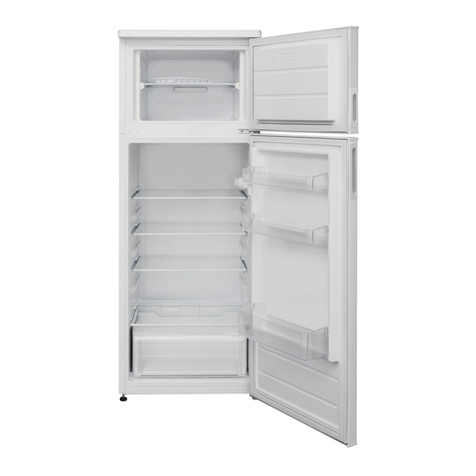
HELKAMA
HELKAMA HJK213EU User manual

HELKAMA
HELKAMA HJK213 User manual
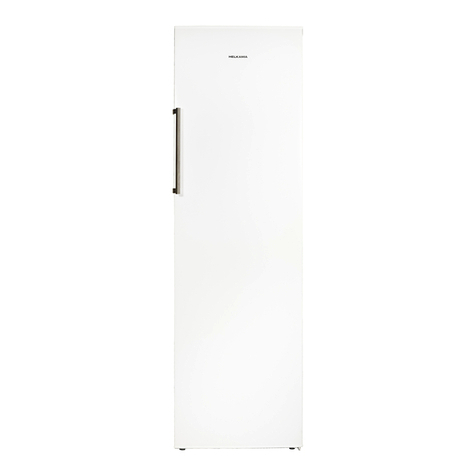
HELKAMA
HELKAMA HJA308F User manual

HELKAMA
HELKAMA HRK336RR User manual
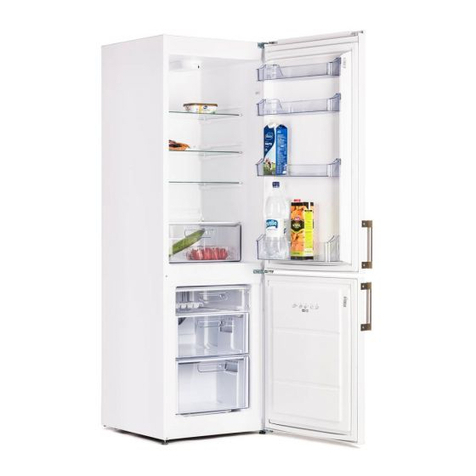
HELKAMA
HELKAMA HJK235M User manual
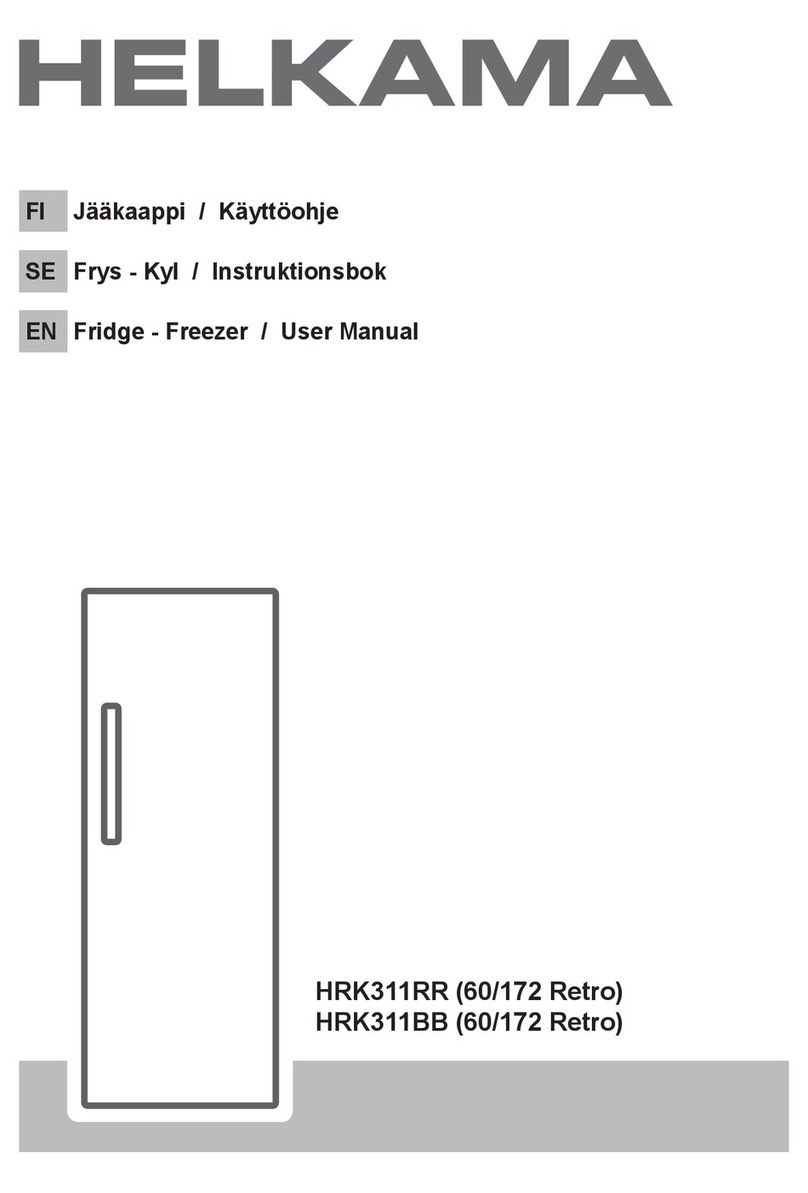
HELKAMA
HELKAMA HRK311RR User manual

HELKAMA
HELKAMA HJK289EU User manual

HELKAMA
HELKAMA HJE350DE User manual
